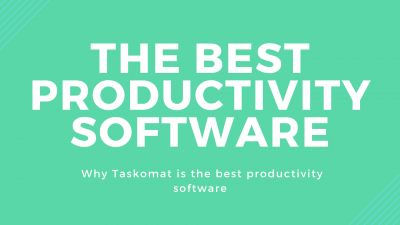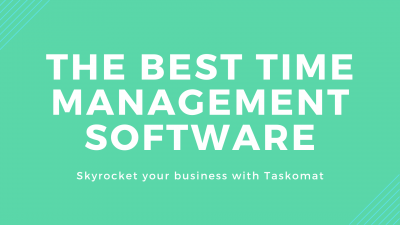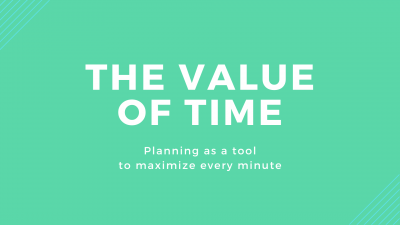The 5 Pillars of Time Tracking
Time tracking does not simply mean noting how long we have taken to complete a task or a project.
Time tracking is a multifaceted practice that includes several integrated activities, approaching the problem from different points of view, sharing the same goal: optimizing time management and maximizing its value.
The 5 cornerstones of time tracking are:
Each of these components has distinct but complementary motivations and benefits, which together contribute to more effective time management and an overall improvement in personal and professional well-being.
Let's specifically look at the psychological motivations and benefits that underlie the 5 steps of time tracking.
Sizing
Sizing in time tracking is a crucial process that involves accurately estimating the time needed to complete various activities or projects. This practice allows for efficient allocation of time resources, improved planning, and increased overall productivity. It is about accurately predicting how long each task will take, based on historical data and experience, with the goal of creating a realistic and manageable schedule.
Psychological motivations
- Reduction of uncertainty
Accurately sizing activities reduces the uncertainty related to the duration of tasks. Knowing how long a task takes allows for more secure planning and avoids the stress of unexpected deadlines.
- Sense of control
Estimating the time needed to complete tasks increases the sense of control over one's work. This can improve confidence in one's time management abilities and reduce anxiety related to complex tasks.
- Motivation and goals
Having a clear idea of the duration of activities allows for setting realistic and achievable goals. This can increase motivation and a sense of personal satisfaction when goals are met within the expected time.
Short-Term Benefits
- Better planning
Accurate sizing of activities allows for more precise and detailed planning. This helps to organize workdays efficiently, ensuring that each task has the necessary time to be completed without overlaps or delays.
- Increase in productivity
With a clear estimate of the time needed for each activity, it is possible to allocate time resources more efficiently, focusing on priority tasks and minimizing wasted time.
- Reduction of stress
Knowing exactly how much time various tasks require reduces the stress and anxiety associated with tight deadlines and an uncertain workload. This leads to a more relaxed and aware time management.
Long-Term Benefits
- Optimization of workload
In the long term, accurate sizing of activities allows for optimal management of the workload. This means that it is possible to avoid periods of overload and burnout, maintaining a sustainable balance between work and rest.
- Development of planning skills
Regularly practicing the sizing of activities improves planning and time management skills. These abilities are valuable for long-term professional success and can be applied in various work contexts.
- Increase in reliability and reputation
The ability to complete tasks within the expected time improves reliability and professional reputation. This is particularly important for freelancers and consultants who depend on client trust for their continued success.
- Improvement of strategic decisions
Having accurate data on the time required for different activities allows for making better-informed strategic decisions. For example, it is possible to assess more accurately the feasibility of new projects or the need for additional resources.
- Resilience and adaptability
The practice of sizing activities promotes greater resilience and adaptability. Being able to estimate and manage time effectively makes it easier to deal with unexpected events and adapt to changes in workload or priorities.
Planning
Planning in time tracking involves organizing the time allocated through the sizing of activities to create an operational plan. This process is essential for maximizing productivity and ensuring that time resources are used effectively. Planning allows you to set priorities, define realistic deadlines, and prevent work overload. Additionally, good planning improves the management of expectations, both personal and of clients, and contributes to a better balance between work and personal life.
Psychological Motivations
- Reduction of anxiety and stress
Planning in advance helps to reduce the anxiety and stress associated with managing multiple tasks and deadlines. Planning offers a clear vision of what needs to be done, reducing uncertainty and improving personal security.
- Sense of control
Establishing a detailed plan for daily and weekly activities increases the sense of control over one's work. This leads to greater confidence in one's time management capabilities and contributes to a perception of efficiency and competence.
- Clarity and focus
Planning allows you to set clear priorities, defining which activities are more important and must be completed first. This helps to maintain focus and avoid being overwhelmed by multiple demands.
Short-Term Benefits
- Better organization
Planning in advance allows for better organization of available time, avoiding overlaps of activities and ensuring that each task receives the necessary attention. This leads to a more structured and productive workday.
- Increase in productivity
With a clear plan in mind, tasks can be completed more efficiently, reducing wasted time and increasing overall productivity. Planning helps to focus on the most important tasks, improving short-term outcomes.
- Reduction of distractions
A well-defined plan reduces distractions, as there is a clear guide on what to do at every moment. This helps maintain focus and reduces time lost on unproductive activities.
Long-Term Benefits
- Achievement of goals
Regular planning helps to establish and achieve long-term goals. By defining intermediate milestones and monitoring progress, it is possible to consistently work towards achieving one's professional and personal goals.
- Improvement of work habits
Constant practice of planning contributes to developing more effective work habits. In the long run, this leads to greater efficiency, better time management, and reduced stress.
- Work-life balance
Effective planning helps to better balance work and personal needs, allowing time for family and recreational activities. This improves the quality of life and reduces the risk of burnout.
- Adaptability and resilience
Regular planning develops greater adaptability and resilience. Being able to predict and manage changes in workload or priorities allows for better handling of unexpected events and maintaining a high level of performance even in stressful situations.
Tracking
This activity involves accurately recording how much time is dedicated to each task or project. Time tracking not only provides a clear view of how every minute of the workday is spent, but also helps identify unproductive habits and replace them with more efficient practices.
Psychological Motivations
- Self-awareness
Time tracking increases awareness of how time is spent. This practice helps identify unproductive habits and replace them with more effective activities. Self-awareness is essential for personal and professional improvement, as it allows for a better understanding of one's habits and behaviors.
- Personal responsibility
Monitoring the time spent on different activities encourages a sense of personal responsibility. Knowing that time is being tracked can encourage more careful and diligent management of one's workdays, reducing the tendency to procrastinate and increasing productivity.
- Management of anxiety and stress
Managing time through tracking can reduce the anxiety and stress related to managing multiple tasks and deadlines. Having a clear view of how much time is spent on each activity helps to prevent work overload and better plan available time.
Short-Term Benefits
- Increase in productivity
Time tracking allows for immediately identifying areas where time is wasted, allowing for quick corrections and improved productivity. People can become more efficient by eliminating distractions and focusing on high-value activities.
- Clarity and structure
Monitoring time provides a clear structure to workdays, allowing to know exactly how much time to dedicate to each activity. This can improve time management and help complete tasks more effectively.
- Immediate feedback
Provides immediate feedback on how time is used. This helps make informed decisions on how to better allocate time resources and adapt time management strategies based on current needs.
Long-Term Benefits
- Continuous improvement
Continuous data collection on time allows for analyzing and reviewing one's work habits over the long term. This continuous reflection facilitates the implementation of incremental and sustainable improvements in time management.
- Optimized project management
In the long term, time tracking contributes to more precise and informed project management. Collected data can be used to better estimate completion times for future projects and optimize resource planning.
- Development of positive work habits
Regular practice of time tracking can help develop more disciplined and focused work habits. Over time, this leads to greater efficiency and better workload management.
- Increase in transparency and trust
Providing detailed reports on the time spent on different activities can increase transparency with clients and collaborators, building trust and improving professional relationships. This is particularly important for freelancers and consultants.
- Better work-life balance
Effective time management helps to find a better balance between work and personal life. This can reduce burnout and improve overall quality of life, promoting sustainable mental and physical well-being in the long term.
Monitoring
Monitoring in time tracking involves overseeing and analyzing the time spent on various daily activities. This practice is crucial for increasing awareness of how time is used, identifying inefficiencies, and improving overall productivity. Monitoring time helps maintain focus on priority tasks, reduce distractions, and provide accurate data for more precise future planning. Continuous monitoring allows for assessing the effectiveness of time management strategies and making incremental improvements to optimize performance.
Psychological Motivations
- Self-regulation
Time monitoring aids in improving self-regulation, which is the ability to control one's thoughts, emotions, and behaviors to achieve long-term goals. Being aware of how time is used fosters greater self-discipline and the ability to maintain focus even in the presence of distractions.
- Improvement of self-efficacy
Tracking time can increase self-efficacy, i.e., confidence in one's abilities to perform tasks and achieve goals. Seeing progress made in daily monitoring can strengthen the perception of competence and the sense of personal accomplishment.
- Reduction of procrastination
The practice of monitoring time can significantly reduce procrastination. Knowing that every minute is accounted for encourages tackling tasks immediately rather than delaying them, reducing procrastinatory behavior.
- Emotional awareness
Monitoring time can increase emotional awareness, allowing one to identify how emotions affect time management. For example, one might discover that stress or anxiety leads to avoidance behaviors, which can be corrected with more effective time management techniques.
Short-Term Benefits
- Immediate improvement in productivity
Monitoring time leads to an immediate improvement in productivity. The data collected allows for quick corrections and focusing on activities that have a significant impact on short-term results.
- Clarity in priorities
Time monitoring provides a clear view of daily priorities. This helps avoid confusion and focus on the most important activities, improving the effectiveness of daily work.
- Immediate feedback on performance
Provides immediate feedback on performance, helping to quickly understand what works and what doesn't. This allows for real-time adjustments to improve efficiency and productivity.
Long-Term Benefits
- Development of sustainable work habits
Continuous time monitoring contributes to the development of sustainable work habits. Over time, this means that time management practices that improve productivity without compromising personal well-being can be consolidated.
- Optimization of work strategies
Analyzing data collected over time allows for optimizing long-term work strategies. For example, one can identify times of the day when one is most productive and organize work accordingly.
- Increase in professional satisfaction
Monitoring time and seeing the progress made can increase long-term professional satisfaction. Achieving set goals and seeing continuous improvement strengthens motivation and the sense of personal accomplishment.
- Improvement of data-based decisions
The data collected from time monitoring allows for making more informed and data-based decisions. This is particularly useful for allocating resources more effectively and planning future projects with greater precision.
- Reduction of burnout
More effective time management through continuous monitoring can reduce the risk of burnout. Optimizing workload and ensuring adequate rest periods helps maintain a balance between work and personal life, improving long-term well-being.
Retrospective
Retrospective in time tracking is the process of reviewing and analyzing completed activities to assess the effectiveness of time management. This step is crucial for identifying areas of improvement, recognizing successes, and implementing strategies to further optimize future performance. The retrospective allows for reflecting on adopted practices, understanding the causes of any inefficiencies, and planning changes to improve productivity. Through regular review, more effective work habits can be developed and better adapted to changes in workload and priorities.
Psychological Motivations
- Self-reflection and personal growth
Retrospective encourages self-reflection, a critical process for personal growth. Reflecting on one's performance and actions allows for recognizing strengths and weaknesses, promoting continuous improvement. This practice helps develop greater self-awareness and identify specific areas where one needs to grow and improve.
- Psychological resilience
Regularly practicing the retrospective builds psychological resilience. Reflecting on past successes and failures and learning from them helps develop a growth mindset. This strengthens the ability to face future challenges and quickly recover from setbacks.
- Intrinsic motivation
Retrospective fuels intrinsic motivation by analyzing progress and recognizing achievements. This practice creates a positive feedback loop that reinforces productive behavior and keeps motivation levels high.
Short-Term Benefits
- Immediate improvement of work strategies
Periodically analyzing one's activities allows for quickly identifying what works and what does not. This enables immediate changes to work strategies, improving efficiency and effectiveness in the short term.
- Recognition and correction of errors
Retrospective facilitates the timely recognition of errors. Reflecting on completed activities helps identify mistakes and develop plans to prevent their recurrence in the future, improving the quality of work.
- Increase in confidence
Reviewing and reflecting on successes and progress strengthens self-confidence. This boost in confidence can have an immediate impact on performance, encouraging a more positive and proactive approach to daily tasks.
Long-Term Benefits
- Continuous growth and development
Regular practice of the retrospective supports continuous growth and development. By constantly analyzing and reflecting on one's performance, skills and abilities can be developed over time, leading to sustainable improvements in productivity and work quality.
- Building positive work habits
Retrospective helps build and consolidate positive work habits. Identifying and replicating productive and strategic behaviors leads to greater efficiency and more effective time management in the long run.
- Improvement of organizational resilience
In a team context, the retrospective strengthens organizational resilience. Analyzing past performances together and learning from mistakes improves team cohesion and the ability to adapt to future changes and challenges.
- Development of a growth mindset
Retrospective fosters the development of a growth mindset, where individuals see challenges as opportunities for learning and improvement. This mindset is essential for long-term success, both personal and professional.
Implementing a Time Tracking Strategy
Using a reliable system for time tracking is crucial to ensure effective and productive time management.
Taskomat is a precise and intuitive tool that allows for accurate tracking of the time dedicated to each activity, facilitating the optimization of resources and the planning of workdays.
Here's how you can use Taskomat to integrate each of these components into your work routine:
- Sizing and estimation
Taskomat allows you to accurately estimate the duration of each activity. This enables better forecasting of future times and optimization of planning, ensuring that each task has the right amount of time allocated and how this is predictively reflected in budget management.
- Advanced planning
With Taskomat, you can create detailed plans for your daily, weekly, and monthly activities. The intuitive interface allows you to efficiently allocate time, set priorities, and establish realistic deadlines, improving overall time management.
- Time tracking system
Taskomat offers a time tracking system that allows for accurately monitoring the time dedicated to each activity or project. You can start and stop timers in real time or manually record hours, ensuring a clear and detailed view of time usage.
- Continuous monitoring
Taskomat facilitates the continuous monitoring of your activities. You can generate detailed reports to analyze how your time is spent, identify inefficiencies, check the deviation between estimates and actual worked time, and make real-time adjustments to improve productivity.
- Retrospective and performance analysis
Taskomat offers performance analysis tools to reflect on past performances. Through detailed reports and intuitive dashboards, you can identify areas for improvement and implement strategies to optimize your future performances.
Conclusion
Taskomat is the ideal tool for implementing the cornerstones of time tracking, offering advanced features for tracking, sizing, planning, retrospective, and monitoring.
By integrating these practices into your work routine with Taskomat, you can significantly improve time management and increase productivity and profitability.



